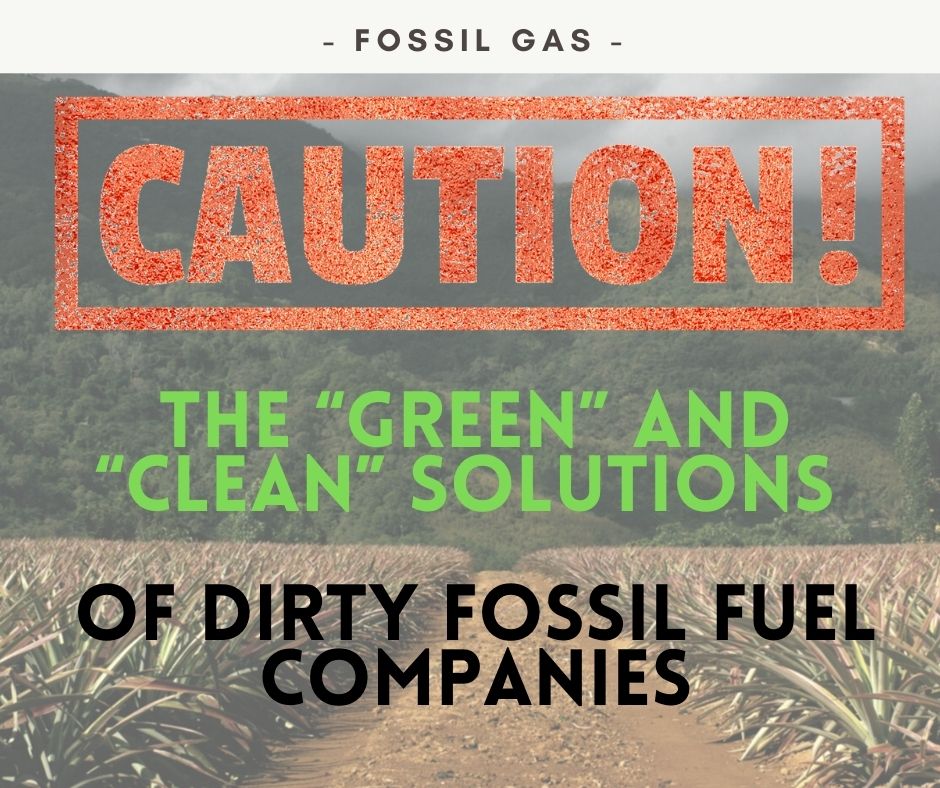The “Green” and “Clean” Solutions of Dirty Fossil Fuel Companies are the Opposite of What They Pretend to be
Not surprisingly, arguments by the fossil gas lobby come in shiny green wrappings to give one of the dirtiest industries around a green veneer.
 Not surprisingly, arguments by the fossil gas lobby come in shiny green wrappings to give one of the dirtiest industries around a green veneer.
Not surprisingly, arguments by the fossil gas lobby come in shiny green wrappings to give one of the dirtiest industries around a green veneer.
There are high profile platforms for fossil fuel companies to propagate their deceptive visions in Brussels and beyond. The COVID-19 crisis moved some of this action online, which has made it harder for corporate polluters to have the informal, post-event “networking time” they use to get what they want from political leaders.
The fossil gas industry is organizing events with buzzwords like “Green Deal”, “clean transition” “decarbonization”, or “sustainability” in their titles, often inviting NGOs or more progressive MEPs to speak. However, bit by bit, more NGOs and critical decision-makers realize that participating in these fossil-fuel industry-sponsored events risks legitimizing the dirty ideas that big polluters are propagating.
In order to limit the manifold ways in which the fossil fuel lobby propagates false solutions, Food & Water Action Europe, together with Greenpeace EU, Corporate Europe Observatory and Friends of the Earth Europe, founded the Fossil Free Politics Campaign. One of our demands is to encourage decision-makers to stop speaking at fossil-fuel company-sponsored events.
Hydrogen Hype and Methane Myths
What are the “solutions” the fossil fuel industry is offering to make it sound like they are ambitious climate change fighters?
An allegedly promising concept, discussed for decades without significant progress, is hydrogen. As we pointed out recently, almost all currently produced hydrogen (over 95%) is based on fossil fuels, mostly gas. The fossil fuel industry wants us believe in the hydrogen hype, and it’s not hard to see why: When gas is used to produce hydrogen, the CO2 generated in the process can be captured and stored (CCS), or even re-used (CCUS).
Converting gas into hydrogen before burning it, so industry suggests, would deal with one of the two main greenhouse gases related to gas: carbon dioxide. But keeping CO2 from getting into our atmosphere and warming our planet is not as easy as they portray it. CCS is an unproven technology, far from larger-scale applicability, and numerous CCS projects have been cancelled, with Europe already dumping over 400 million Euros into a CCS grave that hasn’t delivered. Even if projects really start operating, the capture rate would be insufficiently low with CO2 leaking, causing severe safety issues. CC(U)S projects need enormous energy input to function, making CO2 savings even lower and nowhere near what we need to avoid the worst climate impacts.
So, what about reusing CO2? At the moment, that most often means using it to extract even more fossil fuels from the ground. It should go without saying, but there is nothing sustainable about using some ‘captured’ CO2 to undertake even more polluting activities.
Carbon dioxide is not the only climate-wrecking gas, of course. Fossil gas basically is methane and it can be released into the atmosphere at any point in the supply chain, where it is up to 120 times more climate-wrecking than CO2 in the short term. The EU Commission has announced a “Methane Strategy” that aims to improve monitoring, reporting and verification of methane emissions and leaks. The gas industry likes to promote these plans to suggest that this will fix all problems with methane leakage. But it won’t. Collecting data alone doesn’t eliminate emissions, and despite the available technologies to reduce emissions right now, the “Methane Strategy” is not likely to include concrete requirements.
No Need for These Pipes
In a desperate move to cling to their polluting business model, some gas industry representatives claim that we will be able to decarbonize our energy system while still keeping fossil gas pipes and import terminals. How can that possibly be true? They make a number of what you might call “creative” recommendations.
- Assuming a wildly inflated potential for biogas, which could be transported in existing pipes. This completely ignores that biogas has terrible side effects on people, farmers, animal welfare and biodiversity and is no solution for the climate crisis.
- “Blending” allegedly cleaner gases like hydrogen with fossil gas to try to make the latter more tolerable from a climate point of view, and transport it in existing infrastructure. But this poses a lot of technical problems (many consumers can’t use blended gas mixtures) and offering a gas mix that only looks cleaner will never be enough to decarbonize our energy system.
- EU energy experts with ties to fossil fuel companies are hailing a “multi-purpose” gas network. This implies that existing pipelines, LNG import terminals and compressor stations could easily be used for fossil and other gases at the same time. A particularly far-fetched idea is the suggestion to repurpose LNG to import hydrogen. But liquefying hydrogen is extremely energy-intensive, which will make it inefficient and costly, with no guarantee for sustainability.
Fossil Gas Cannot Be Part of Any Climate Solution
It is up to campaigners to hammer home the message over and over again: Fossil gas is not a solution to the climate crisis, but one of its causes. It is certainly not suitable as a transition fuel and needs to be phased out now. This most fundamental urgency is too often ignored by decision makers in the EU, and discussions around the upcoming revision of a regulation on energy infrastructure projects still include the possibility of prioritising and providing EU tax money for fossil gas projects in “transition regions” such as Polish coal regions.
The growing movement against gas is needed more than ever to debunk false solutions and fight for a clean energy system for Europe and beyond.


